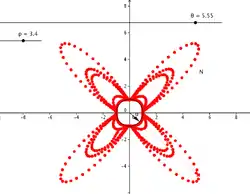Nehari manifold
In the calculus of variations, a branch of mathematics, a Nehari manifold is a manifold of functions, whose definition is motivated by the work of Zeev Nehari (1960, 1961). It is a differentiable manifold associated to the Dirichlet problem for the semilinear elliptic partial differential equation

Here Δ is the Laplacian on a bounded domain Ω in Rn.
There are infinitely many solutions to this problem. Solutions are precisely the critical points for the energy functional
on the Sobolev space H1
0(Ω). The Nehari manifold is defined to be the set of v ∈ H1
0(Ω) such that
Solutions to the original variational problem that lie in the Nehari manifold are (constrained) minimizers of the energy, and so direct methods in the calculus of variations can be brought to bear.
More generally, given a suitable functional J, the associated Nehari manifold is defined as the set of functions u in an appropriate function space for which
Here J′ is the functional derivative of J.
References
- A. Bahri and P. L. Lions (1988), Morse Index of Some Min-Max Critical Points. I. Applications to Multiplicity Results. Communications on Pure and Applied Mathematics. (XLI) 1027–1037.
- Nehari, Zeev (1960), "On a class of nonlinear second-order differential equations", Transactions of the American Mathematical Society, 95 (1): 101–123, doi:10.2307/1993333, ISSN 0002-9947, JSTOR 1993333, MR 0111898
- Nehari, Zeev (1961), "Characteristic values associated with a class of non-linear second-order differential equations", Acta Mathematica, 105 (3–4): 141–175, doi:10.1007/BF02559588, ISSN 0001-5962, MR 0123775
- Willem, Michel (1996), Minimax theorems, Progress in Nonlinear Differential Equations and their Applications, 24, Boston, MA: Birkhäuser Boston, ISBN 978-0-8176-3913-6, MR 1400007